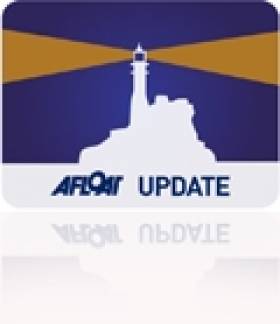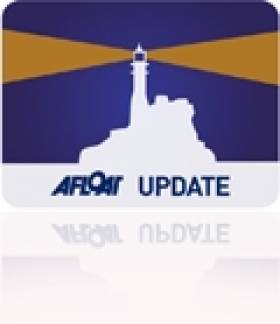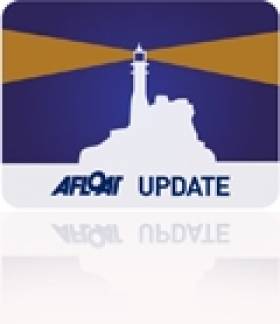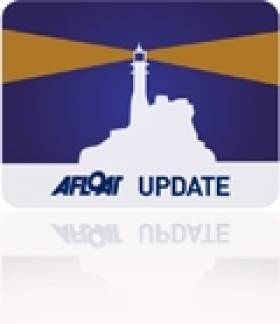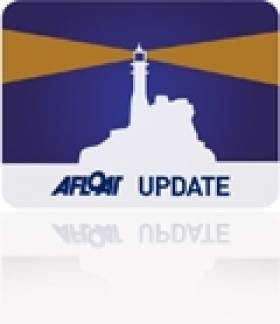Displaying items by tag: Fastnet
RAN Looking Good For Second Victory
After the drama of Tuesday's capsize of Rambler 100 finishers of the Fastnet race continue to arrive in Plymouth. Following the arrival of the 100 foot supermaxi ICAP Leopard (GBR) this morning, so the first of the Mini Maxis arrived in Plymouth this afternoon in the form of 2009 Rolex Fastnet Race winner, Ran (GBR).
The Judel Vrolijk 72 campaigned by Skype co-founder Niklas Zennstrom crossed the line off Plymouth at 12:53:44 BST, in an elapsed time of 2 days 3 minutes, and 44 seconds.
Ran benefitted from the retirements yesterday of 80-foot Beau Geste (HKG) and 68-foot Alegre (GBR). According to Gavin Brady, Beau Geste was forced to pull out when some cracking developed in her deck and with conditions set to build around the Fastnet Rock and the onset of night, they chose to err on the side of prudence, the boat this afternoon was back in Gosport.
While they had been putting miles on Alegre behind them, Ran was on Beau Geste's tail when she retired. Navigator Steve Hayles says they would have had a tough time holding on to Beau Geste reaching back from the Rock; however, despite lively conditions with the wind peaking at 30 knots, their luck with the weather could not have been better for their rounding of the Rock.
According to Zennstrom, before the race start the forecast was indicating that this year's Rolex Fastnet Race would not just be a big boat race, but a 'very big' boat race, so they were looking ahead at Beau Geste, ICAP Leopard and Rambler 100, rather than at the smaller boats behind them. With two of these retired, Ran looks to be a strong contender for successfully defending her Rolex Fastnet Race title this year.
After the Volvo Open 70s arrival early this morning, later there was an equally close finish between the first three IMOCA Open 60s. This contest for the boats best known for being sailed singlehanded around the world in the Vendee Globe, was won by 2004-5 Vendee Globe winner Vincent Riou in his orange PRB (FRA). She was less than four minutes ahead of Virbac Paprec 3 (FRA) skippered by Jean-Pierre Dick, two-time winner of the Barcelona World Race, in turn less than two minutes ahead of two-time Velux 5 Oceans solo round-the-world race winner, Bernard Stamm on his Cheminees Poujoulat (SUI).
The next boats set to finish in Class Zero are the STP65 Vanquish (USA), while the Swiss TP52 Near Miss late this afternoon was off the Scilly Isles. But based on times taken at the Fastnet Rock, Ran remains ahead on corrected time. In IRC 1, the Swan 62 Uxorious IV (GBR) leads under IRC, while of the eight boats to have rounded in IRC 2, the A40 Vitaris Response (FRA) was in front.
With an area of high pressure encroaching over the Celtic Sea, the wind is forecast to continue veering into the north and then northeast tonight and lightening over the next 24 hours, with, in stark contrast to what the frontrunners experienced, precious little wind at the Fastnet Rock tomorrow afternoon.
As of 1900 BST, 13 boats have finished the race; approximately 273 were still racing, and 28 have retired.
Fastnet Race Monohull Record Falls
The black-hulled VO70 arrived at an overcast and drizzly Plymouth finish line at 07:49:00 BST this morning, just under 5 minutes ahead of Franck Cammas' VO70 Groupama 4 (FRA). In doing so she broke ICAP Leopard's 2007 record by 1 hour 39 minutes.
Despite this, for ICAP Leopard, line honours winner in the last two Rolex Fastnet Races, the race was still good as she had led her faster rival, George David's supermaxi Rambler 100, for more than 24 hours.
"It was a very good race," commented owner Mike Slade. "The weather at the beginning and the end, and the surge around the top were very, very exciting and we were all doing big numbers. I thoroughly enjoyed coming out of the Solent - we led Rambler there and led her most of the way up to the Rock. Rambler is a quicker boat in terms of righting moment and weight. So that was a great thrill."
In the fog, Slade says that they knew there was an issue with Rambler but not the full extent of what had happened (of her keel loss and subsequent capsize). When they passed the location of the incident, between the Fastnet Rock and the Pantaenius offset mark, there had been thick fog.
The three Volvo Open 70s subsequently sped past ICAP Leopard in the 20-30 knot winds heading across to Bishop Rock.
According to Slade this may be ICAP Leopard's last Rolex Fastnet Race before she goes in for a major refit over this winter that will effectively transom her into a superyacht with a full luxury interior. "I have done about eight or nine Fastnet races but I think this is as good as it gets," said Slade.
Previous monohull record holder ICAP Leopard at Fastnet Rock Credit: Rolex/Carlo Borlenghi
For the three Volvo Open 70s competing in this year's Rolex Fastnet Race, this was the only occasion they will line up before they set off round the world this autumn. Their race around the 608-mile course was formidable, with Abu Dhabi, Groupama 4, and Team Sanya, skippered by former Volvo Ocean Race winner (and Rolex Yachtsman of the Year) Mike Sanderson, each holding the lead for parts of the race.
"It was wet," recounted Abu Dhabi skipper, Ian Walker. "From half-way across the Irish Sea to the [Fastnet] rock and back was flat out. I think our average was into the 20s, blast reaching, and we definitely hit 30 knots on a couple of occasions. And it was a great race."
They had shared the lead with the French VO70 along the south coast of the UK while Team Sanya pulled ahead after cutting the corner at Land's End. Abu Dhabi had regained the lead before rounding the Fastnet Rock, and were then overhauled again by Groupama 4 on the reach back to the Scilly Isles. However ultimately Abu Dhabi took the win, passing Franck Cammas' VO70 as they rounded the Lizard this morning, to finish just 4 minutes and 42 seconds ahead of them, with Team Sanya coming in an hour later.
"It is fantastic to win this race. When you have 100-footers, normally no one gets a look in, so to win it in a 70 foot boat is pretty cool," said a contented-looking Walker upon his arrival into Plymouth's Sutton Harbour. "And it is nice to do a race. I haven't done one for about a year and I can't remember the last time I won one! It is also especially good for the shore crew and all the people who have been working 12 hours a day to build the boat and get us here."
The Rolex Fastnet Race was not without its incidents and Walker reeled off a list including flooding the engine, ripping a block off the deck, dropping the media computer in the water, etc. But their troubles were small fry compared to those experienced on Team Sanya.
Ian Walker reported how while rounding the Fastnet Rock they had had to slow down from 25 knots in order to allow the bowman to change the headsail. When Team Sanya attempted this there were further complications that at one stage forced them to point their bow the opposite way back up the racecourse. They also snapped their main sheet when it chafed through on a newly resurfaced winch, also forcing them into some downtime. Most dramatic of all was when one of the thru-hole fittings in the hull blew off causing a major flood.
"We had tons of water downstairs, so we were hovering bow down, but the rule is great because we have great pumps - although they have been used a bit too often in this program!" recounted Sanderson.
Having won the 2005-6 Volvo Ocean Race, Sanderson was not involved in the 2008-9 event, but seemed elated by his return to the class that made his name. "I was a bit apprehensive about coming back and doing the race, but I love it and everything about it. It is a great team and you forget how cool the boats are; doing 30 knots in a 70-footer with another one beside you doing 30 knots. The Volvo boats - they never cease to amaze. You get back on them and it is like 'man, these things are quick'. And we are really pleased with the result."
Groupama 4 made a swift about-turn back towards her base in Lorient, France immediately after finishing. "We had a great race and we fought well. Unfortunately we finished just behind Abu Dhabi," said skipper Franck Cammas. "It was really interesting to find ourselves competing with our future rivals in the Volvo. Our performances are very close and there should be some interesting battles ahead."
Meanwhile more details have emerged of the keel loss and subsequent capsize of George David's maxi Rambler100 that occurred shortly after they rounded the Rock at 17:25 BST yesterday. Project Manager, Mick Harvey, who was on board at the time, said: "We were beating into big seas, launching Rambler off the top of full-size waves. I was down below with navigator Peter Isler when we heard the sickening sound of the keel breaking off. It was instantaneous; there was no time to react. The boat turned turtle, just like a dinghy capsizing. Peter Isler issued a Mayday and we got out of there as quickly as we could."
Crew on deck were able to clamber over the lifelines and onto the upturned hull and helped those that had ended up in the water. However the swell made it difficult for all the crew to get out and five, including skipper George David and partner Wendy Touton, were swept away and out of reach. This group linked arms, forming a circle, but ended up in the water for two and a half hours. Fortunately the Coastguard diverted a local fishing boat to assist, which winched the remaining crew on board. From there Wendy Touton, suffering from hypothermia, was airlifted to hospital for medical attention. The remaining four were taken to Baltimore Harbour where they were re-united with the 16 crew members who had been rescued from the upturned hull of Rambler 100 by the Baltimore Lifeboat.
As of 1200 BST, 12 boats have finished the race; approximately 275 were still racing, and 27 have retired.
Government Minister Commends Emergency Services in Fastnet Rescue
"This was a dramatic sea rescue that was co-ordinated with speed and professionalism and everybody involved should be commended for their efforts. This is a reminder of just how important it is for Ireland to have a well resourced sea rescue infrastructure."
Minister Coveney went on to say "The Fastnet race is one of the most high-profile offshore yacht races in the world and Rambler 100 is one of the best known racing yachts on the planet. This incident will be reported in the international press and we can be proud of the way in which Irish emergency services contributed to preventing any loss of life."
"Most importantly, my response is one of relief that there was no loss of life, which considering the size and speed of the yacht and the conditions at the time, is a minor miracle. I hope everyone involved will make a full recovery."
Rambler 100 Capsize - 'A Scary Moment We Will Not Forget'
At midnight, Monday 15 August, Eddie Warden Owen, Chief Executive of the Royal Ocean Racing Club received a call from Mick Harvey, Project Manager of George David's Rambler 100 (USA). Harvey spoke about the harrowing incident when the 100' Maxi Rambler 100 capsized in the Celtic Sea during the Rolex Fastnet Race.

The incident happened just after Rambler 100 rounded the Fastnet Rock at 17:25 BST. At the time, Rambler 100 were leading the monohull fleet and vying for monohull line honours in the Rolex Fastnet Race which started on Sunday 14th.
Mick Harvey's account of the incident was charged with emotion. The tough Australian, who now lives in Newport, Rhode Island (USA), is a seasoned veteran, but he was understandably shaken by the incident:
"Soon after rounding the Fastnet Rock, the wind went southwest, right on the nose. We were beating into big seas, launching Rambler off the top of full size waves. I was down below with navigator, Peter Isler when we heard the sickening sound of the keel breaking off. It was instantaneous; there was no time to react. The boat turned turtle, just like a dinghy capsizing. Peter Isler issued a Mayday and we got out of there as quickly as we could."
The EPIRB had been activated and a number of crew climbed over the guardrails and onto the hull as the boat capsized and helped those swimming to safety. The Atlantic swell made it difficult for the crew to get out of the water however, working together, 16 of the crew managed to scale the upturned hull.
Five of the crew were swept away by the waves out of reach of the stricken Maxi and these included Skipper, George David and partner Wendy Touton who were in the water for two and a half hours. This group linked arms, forming a circle. Valencia Coastguard diverted a local fishing boat, Wave Chieftain to assist, which winched the crew on board. Earlier a helicopter had been scrambled from Shannon Airport helicopter, Wendy Touton was airlifted for medical attention due to the effects of hypothermia and the four remaining crew were taken to Baltimore Harbour where they were re-united with the 16 crew rescued by the Baltimore Lifeboat.
"It was a scary moment. One that I will never forget," admitted Mick Harvey. "I can't begin to tell you how relieved I am that all of the crew are safe. The town of Baltimore has given us a wonderful welcome. I can not thank our rescuers and the people of this lovely village enough. Wendy is in Kerry Hospital and doing fine, I am just so relieved that everybody is okay."
Rambler 100 Crew Member 'Feels Lucky to be Alive'
An Australian crewmember on the stricken Rambler 100, which capsized in high winds during yesterday's Rolex Fastnet Race, has told reported that he feels "lucky to be alive".
Mike Motti was one of five crew who were separated from the yacht when it overturned near Fastnet Rock off the Cork coast.
He and his fellow crewmembers spent two hours adrift on a liferaft before they were rescued in foggy conditions which made the search all the more difficult.
“I’m feeling lucky to be alive, happy to be here and it’s great to see the local people here to greet us,” Motti told The Irish Times.
Fellow crewman Michael van Beuren said the yacht capsized within 30 seconds when its keel fin snapped in heavy seas.
All 21 crew were rescued from the yacht last night in an operation led by the Baltimore RNLI lifeboat and the Irish Coast Guard.
Phaedo Team's Dramatic Rescue Photos of Rambler 100 Crew
Antoher competing yacht in the Fastnet race captured dramatic photos of the stricken 100-footer. Team Phaedos' media personnel who were at the Fastnet Rock last night waiting for photogrpahs of their big catamaran passing 'the Rock' when they got a call from the Irish Coastguard for all ships in the area to be on standby.
The media crew immediately abandoned the photography project and called in to the Coasguard to offer help. They found all crew on the up-turned hull of Rambler were fine and well, but 5 crew had drifted off from the upturned hull and were no longer in sight. They searched the area were they had received a personal EBIRB transmission from and miraculously found the missing 5 crew after they had been in the water for 3 hours.
"We pulled aboard our dive vessel owner George David and his four crew members who had all been strapped together, cold, but healthy, happy, safe, and well" said Team Phaedo's Rachel Jasperson. Dramatic Photos below.


r
Baltimore RNLI lifeboat crew were involved in the major rescue operation this evening (Monday 15 August 2011) when a 100 ft yacht capsized during the famous Fastnet race with a crew of 21 onboard. Five of the crew were missing when the lifeboat arrived on scene while the remaining sixteen were huddled together on the upturned hull.
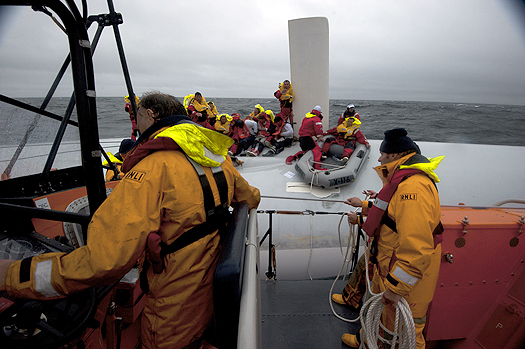
Baltimore lifeboat finds crew clinging to a daggerboard. Photo: RNLI
The Baltimore RNLI lifeboat was out on exercise near the Fastnet rock when they were alerted by Valentia Coast Guard that an emergency signal had been picked up. The lifeboat volunteer crew under Coxswain Keiron Cotter proceeded to the area and started a search. About sixteen miles southwest of Baltimore and five miles south of the Fastnet the lifeboat crew spotted the upturned yacht with the sixteen crewmembers on the hull. They told the lifeboat volunteers that five of their crew had drifted away from the yacht. After a short search the Coxswain returned to the scene and recovered the casualties onboard. They had been there for approximately three hours since their yacht capsized shortly after 5.30pm.
The other five crewmembers who were missing had managed to tether themselves together and were spotted in the water by the Baltimore deputy mechanic Jerry Smith who had taken out his own Dive boat to join in the search. One of the five was airlifted by the Irish Coast Guard helicopter to receive medical attention.

Rescued crew rejoice that all are safe, some spent three hours in the water. Photo: RNLI
The remaining twenty were brought ashore at Balimore Harbour and taken to the local sailing club to be assessed.
Baltimore RNLI Coxswain Keiron Cotter said, "We had no idea what we were looking for and it was extremely hard to spot the upturned yacht in the water. They had been there for about three hours with other vessels in the race passing nearby but not being able to see them. We were out on exercise in the area where they capsized and we must have just missed them by minutes.
We saw a light in the distance and did not know what it was so we went closer to investigate it. When we got nearer we saw that it was a torch the casualties were flashing to attract attention. Our priority was to get them back to shore as quickly as possible."
More photos and latest news in our Fastnet Coverage here
Fastnet Yacht Capsizes Off Cork Coast - Latest
A US entrant in this year's Rolex Fastnet Race capsizsed near Fastnet Rock off the Cork coast earlier this evening, The Irish Times reports.
Further to our previous report, The Irish Times notes that 22 people were on board the Rambler 100, which overturned in force-five winds at around 6.30pm this evening.
The Department of Transport confirmed that all crew have been accounted for, with 16 sitting in the hull of the boat and the remainer on life rafts.

Rambler 100 rounds the Fastnet Rock. Photo: Daniel Forster/Rolex
RNLI Baltimore's lifeboat and the Irish Coast Guard are currently attending. Coastguard helicopters have also been dispatched, with naval vessel LE Clara giving assistance. The rescue effort has been hampered by misty conditions in the area this evening.

Baltimore lifeboat at the scene of the capsized Rambler 100. Photo: Carlo Borlenghi/Rolex
Rambler 100 recently set a new world record for the almost 3,000-nautical mile transatlantic crossing from Newport, Rhode Island to Lizard Point in Cornwall with a time of 6 days, 22 hours, 8 minutes and 2 seconds.
In other Fastnet action, there was disaster in IRC Z this afternoon for co-skippers Karl Kwok and Jim Swartz’s Farr 80 Beau Geste (HKG).
The yacht suffered a ‘structural problem’ while mid-away across the Celtic Sea en route to the Rock. She has since turned her bow back towards Land’s End.
Yesterday there was another high profile retirement when Johnny Vincent’s TP52 Pace (GBR) returned to her berth in the Hamble with mast problems.
In the Class 40s John Harris’ GryphonSolo2 (USA) has also pulled out, retiring to Dartmouth with sail damage.
- Fastnet
- Cork
- Rolex Fastnet Race
- Lifeboat
- Coastguard
- Irish Coast Guard
- Transatlantic
- Hamble
- Search and Rescue
- Fastnet Rock
- Department of Transport
- world record
- Helicopter
- 2011
- capsize
- TP52
- Land's End
- Rambler 100
- RNLI Baltimore
- IRC Z
- Kark Kwok
- Jim Swart
- Farr 80
- Beau Geste
- Johnny Vincent
- Pace
- John Harris
- GryphonSolo2
- Dartmouth
- Class 40
RORC's Racing Manager Ian Loffhagen said tonight a further statement will be released when more information becomes known.
Fastnet Latest: Maxi Multihulls Round the Fastnet Rock
Last night both boats, along with the two MOD70 trimarans Veolia Environnement (FRA) and Race for Water (SUI), overstood the Scilly Isles, in order to lay the Fastnet Rock in one tack and take advantage of a small left hand wind shift while crossing the Celtic Sea between the southwest end of England and the south coast of Ireland. The reason Gitana 11 (FRA) is so close is that after leaving the Scillies to starboard she tacked north for the Rock earlier than her larger rival, sailing a substantially shorter course as a result.
At the time the two on the water leaders rounded the Fastnet Rock this morning, the wind had dropped to 10 knots from the west-southwest and the sea state had abated.
Meanwhile in the heavyweight bout between the 100 foot super-maxi monohulls, the crew on Mike Slade's ICAP Leopard (GBR) are doing a fine job fending off the attack of George David's faster Rambler 100 (USA). The two boats passed between the Scilly Isles and Land's End at 0630 BST this morning, but there were a large group of powerful boats shadowing them close behind.
The three Volvo Open 70s passed between Land's End and the Scilly Isles at around 0830 BST this morning and Mike Sanderson's Team Sanya (CHN) had pulled off a similar move to Gitana 11 in tacking north earlier than her two rivals and this was enough to give her an 8-mile lead on her rivals, the Ian Walker-skippered (UAE) and Franck Cammas' Groupama 4 (FRA). However closest to the two super- Abu Dhabi Ocean Racing maxis as they head out across the Celtic Sea was the Farr 80 Beau Geste (HKG), skippered by American Jim Swartz, just two miles ahead of Team Sanya at the latest update this morning.
Meanwhile, looking good on handicap in IRC Z was Niklas Zennstrom's J-V 72 Ràn (GBR), winner of the 2009 Rolex Fastnet Race. Ràn was taking a similar westerly track to Abu Dhabi and Groupama 4, just four miles ahead of her. This morning the bulk of IR Z are rounding the Lizard, off the south of Cornwall, while IRC 1 is still mid-way between the Lizard and Start Point with the Swan 62, Uxorious IV (GBR), leading on the water.
The IRC 2 fleet is close behind IRC 1 with the trio of RORC Commodore Andrew McIrvine's First 40 La Réponse, the J/122 Joopster and the A-40 Vitaris Reponse leading the charge on the water.
Like IRC 2, the majority of the IRC 3 fleet were tacking a long tack out into the Channel, with Geronimo 2 was leading on the water. The leaders in IRC4 were also mid-way between Start Point and the Lizard with the S&S 41 Winsome ahead on the water.
Overnight there have been a few more retirements. Aboard the Sigma 38 Zanzara in IRC 4, a crewman was lifted off with a broken leg at 0745 this morning. Meanwhile Richard Palmer's J/109 Jangada Too is retiring into Plymouth with electrical problems.
The weather situation remains complex with a compact depression to the west of Ireland, a substantially larger depression over Iceland, and an area of high pressure over the Bay of Biscay. For those venturing across the Celtic Sea, the movement of these fronts early Tuesday morning is key as they will cause a wind shift from the southwest to the northwest.
The Rolex Fastnet Race finish is in Plymouth Harbour. The main trophy for overall victory in the Rolex Fastnet is the Fastnet Challenge Cup. In addition, there are more than 30 other trophies that will be awarded at the prize giving on Friday, 19 August at the historic Royal Citadel. The Citadel, home to the 29 Commando Regiment Royal Artillery, overlooks Plymouth Sound and Sutton Harbour, where the majority of the fleet will berth.

